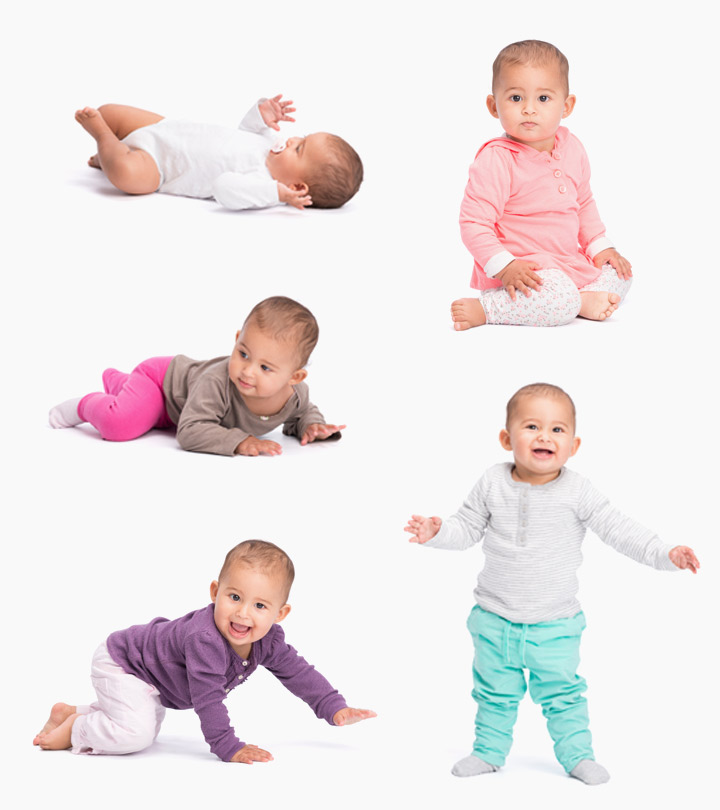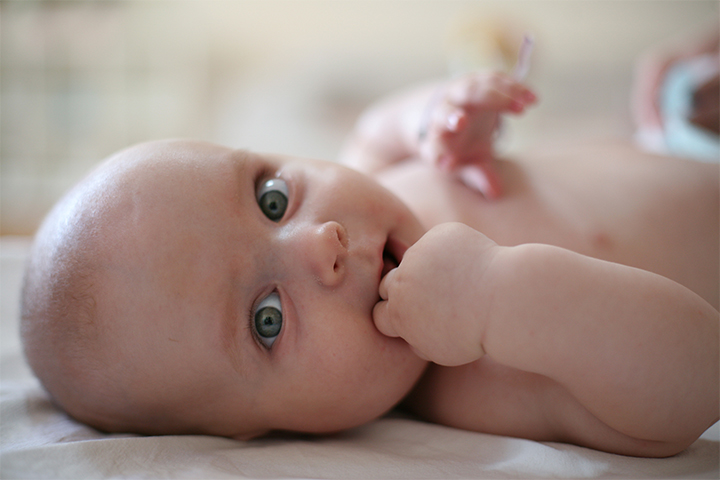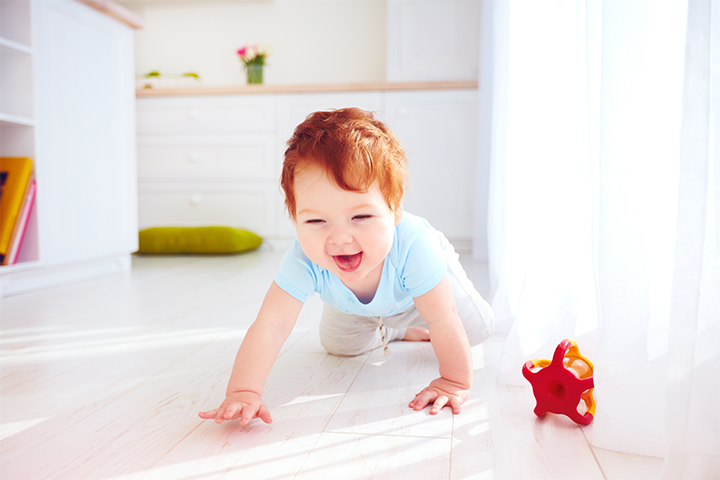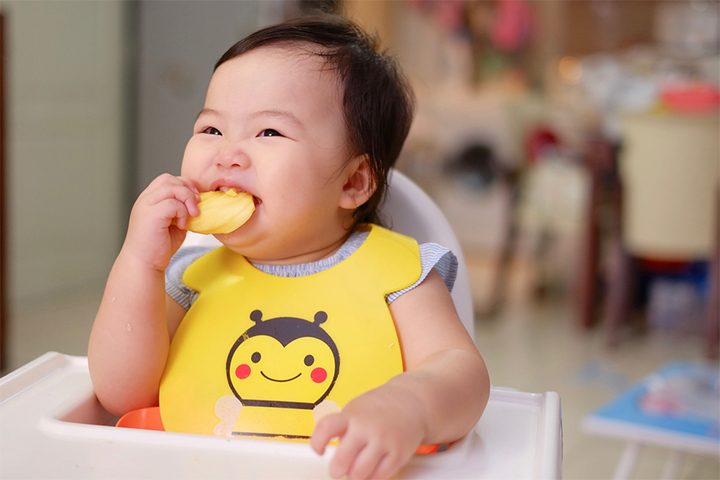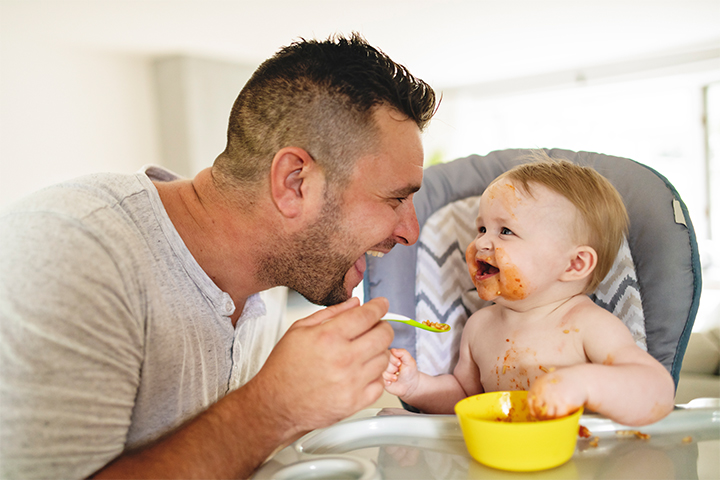Physical development in infants is fast. It seems like only yesterday that your baby was so small that you could completely encircle them in your arms. Now, the baby has grown several centimeters and is approaching new developmental milestones on a daily basis. These bodily changes are critical for the development of a baby’s motor abilities and total body growth. It also provides the groundwork for your baby’s future physical growth and abilities.
So, what are those characteristics of physical development? Continue reading this post to learn about physical growth signals in newborns and toddlers to widen your parenting knowledge.
What Is Physical Development In Infants And Toddlers?
Physical development pertains to the baby’s bodily growth, fine and gross motor skills, and the abilities of various organs of the body. When a baby achieves a new physical capability, his life improves, and that is an event in his physical growth calendar.
We list down such growth indicators in babies and toddlers of different age groups, from birth until the age of 36 months (three years).
Physical Development For Various Age Groups
1. 0-3 Months:
- Muscular growth: The growth in neck muscles lets the baby hold the head up when lying flat on the tummy. It is an important physical development milestone, which indicates improved muscle strength and flexibility.
- Motor skills: By the age of two months, the baby will display smoother movement of limbs (1), indicating an improvement in the functionality of motor neurons. At the age of three months, he is flexible enough to bring hands to the mouth, open and close hands to make a fist, and move legs in a bicycling movement (2).
- Development of organs: The baby’s digestive system improves since birth and is slowly growing robust thanks to the inflow of antibodies from the mother’s breast milk. His vision is not as good as an adult’s, but the eyes can coordinate better due to the improved dexterity of ocular muscles that move the eyeballs. He can identify a human face and by six to ten weeks of age, he can fix his gaze on an object and follow it to a certain extent.
2. 4-6 months:
- Muscular growth: Body surges in growth since tissues add layers of new cells with a noticeable increase in muscle mass. Neck muscles keep the neck unsupported, while the leg muscles push the leg down when the baby is held vertical. Some babies may roll over from tummy to back in the fourth month (3). By the end of the sixth month, a baby can roll from tummy to back and from back to the tummy. The baby also begins to sit without support by the end of six months.
- Motor skills: The baby can grasp a small toy with both hands or reach out for it with either left or right hand. Develops raker grasp, which is the ability to use all the fingers at the same time to maintain grip (4). He will shift the toy from one hand to another. Also, when lying down, he will bring legs closer to the chest to play with them with his hands.
- Development of organs: Eyes can see better, which means the baby will curiously look at the world around him. Perceptual development improves, and by the end of the sixth month, the baby has the same color vision as an adult His hearing improves, and the little one turns towards familiar voices, sounds, and other noises (5).The digestive system is all set to go beyond breastmilk and consume pureed solid food. Speech improves due to language development, and the little one can babble.
3. 7-9 months:
- Muscular growth: Muscles are strong to support the weight of the body when the infant gets on all the four limbs. The baby now crawls, which is perhaps the most significant physical development in infancy. During tummy time, he will push elbows down and slowly raise his head to look above. The baby will also extend his hands to reach objects at a distance, displaying greater muscle dexterity. He will also get into a sitting position by himself. If you provide him support, the baby can stand for a few seconds.
- Motor skills: Has stronger grip and shakes toys like rattles. Develops pincer grasp, which is using thumb and index finger to pick up tiny objects. Manipulates objects in hands without dropping them. On seeing something interesting, he will crawl towards the object and get into a sitting position to pick the object with precision. He will also poke at things to explore them. The baby can now hold the bottle independently while feeding, without losing grip on it.
- Development of organs: Vocal chords are now capable of making a range of sounds including “mama” and “dada”. Vision is now as good as an adult’s. Eyes have an ability to see moving objects without losing track of them. The baby can identify familiar voices from a pool of sounds.
4. 10-12 months:
- Muscular growth: Skeletal muscles are stronger, and have a wider range of movement. The baby crawls faster and quickly switches between crawling to sitting. He will also be able to crawl up and down the stairs. The infant will pull up to the standing position and walk with support, which is called cruising (6). He can also walk without support for shorter distances.
- Motor skills: The baby has an acute sense of balance. There is improved motor control, and the baby can release an object from his hand gently instead of dropping them. Fine motor skills improve, letting the infant turn the pages of the book (7).
- Development of organs: The skeleton has an increased bone density. Sight and vision are better than a few months ago. The digestive system can process more types of food items than before.
5. 13-15 months:
- Muscular growth: The baby now steps into toddlerhood and can stand alone for a longer time than before. He can bend while standing and still maintain his balance. Limbs perform complex movements, which makes it easier to dress and undress the toddler.
- Motor skills: The major physical development in toddlers is the ability to feed himself with finger foods. He is less messy and puts food in the mouth with precision. The baby can place shapes in sockets with accuracy. At the end of 15 months, a toddler will be entirely comfortable holding a sippy cup and may stop using bottles all together. He can hold a sketch pen to draw doodles or basic drawings.
- Development of organs: Vision is now exactly as an adult’s, and eye coordination is precise. Stomach and intestines can process a wider array of food items. The next significant development of internal organs will now happen at 24 months.
6. 16-18 months:
- Muscular growth: The toddler can pedal a tricycle and can walk without support for longer distances. He may also run for short bursts and climb steps holding support. The toddler now prefers walking to crawling thanks to the well-developed back and leg muscles. He can also lift toys, which he found heavy some months ago.
- Motor skills: The toddler can now start drinking from an open cup and eat with a spoon (8). He can set the building blocks one over the other. He has a firm hold on a sketch pen. He can remove some parts of clothing, for example, he can pull out a sock. There is a greater nimbleness in hands, which lets him pull, push, and rotate objects with ease.
7. 19-21 months:
- Muscular growth: You notice he is gaining height since tissues in the body are growing at a rapid pace. The toddler has a firm grip, and can easily pick objects from the ground and carry them. He wears a full backpack without getting tired thanks to the stronger back muscles.
- Motor skills: A significant physical development at this stage is the ability to use pen/sketch pen more accurately. He now draws a vertical line and is nimble at drawing shapes. The toddler has the fine motor skills to throw a ball underhand and build toy towers with more building blocks. He can turn pages of a book with precision and turn multiple pages at once to reach a further page in the book.
8. 22-24 months:
- Muscular growth: The toddler is stepping into the phase of a preschooler, and this means he has greater agility of muscles than before. He bears weight evenly on both his feet and no longer wobbles while walking, which indicates rigor in his physical development. In fact, his body is now strong enough to bear the entire weight on his toes, and toddlers by the age of two years can tiptoe (9).
- Motor skills: You will notice a plethora of things. The little one can now kick a ball, throw it overhand, can make himself sit on a piece of furniture like a sofa, and has a proper grip over a pen. He has a better ability to draw a cross.
- Development of organs: At the end of 24 months that is two years, the toddler’s digestive system and immune system are less prone to allergies, and he can eat almost all types of food viz. all grains including wheat and dairy products including ice creams (10).
9. 25-29 months:
- Muscular growth: The toddler has grown considerably in the last few months and loves playing active outdoor games that help strengthen the muscles. Legs muscles are robust. Can switch from multiple positions, such as standing from a sitting position and vice-versa. It indicates greater strength in muscles and improved motor neuron impulses.
- Motor skills: He can now dress up himself. The preschooler will know how to use buttons, like that of a remote, and will press them with precision, indicating that his fine motor skills are now agile. He loves playing with building blocks and can stack them with better precision so as to prevent them from collapsing. Toddlers at this age can brush their teeth once trained by a parent or dentist.
10. 30-36 months:
- Muscular growth: The toddler’s physical development peaks as he approaches his third birthday. His muscles are capable of doing a variety of actions like jumping and climbing up the stairs. You observe an increase in his physical endurance and stamina since he does not get tired of playing. The preschooler has enhanced body balance and catches a ball while running, without tripping over. The little one will enjoy the process of exploration with his newfound strength by tugging or picking it up.
- Motor skills: Limb coordination improves as he can swing a bat or throw a ball straight into the air. He can hold tiny objects with extreme precision. Board games with small pegs entice him since he can use them with ease. He now draws shapes quite well and enjoys tracing an illustration using a stencil. When walking on uneven surfaces, he may use the support of his hands and fingers to maintain balance, indicating an improvement in gross motor skills. He can fold paper as instructed, and tear it properly as well. This progress goes hand in hand with cognitive development.
- Development of organs: The preschooler can eat all varieties of vegetables, fruits, and meat. His digestive system has developed a more adult-like digestion cycle, which makes him hungry at predictable intervals. He also has better toilet control and can hold the nature call until he finds a bathroom. Most toddlers are toilet-trained, at least when they are not sleeping. When it comes to sleep, a three-year-old should sleep between 10-13 hours, but will also feel content with nine hours of sleep (11).
After reading through our exhaustive details of physical development, you might want to go through the concise version for future references. Here it is for you:
Physical Development Chart
| Age range | Physical developments | Signs of developmental delays |
|---|---|---|
| 0-3 months |
|
|
| 4-6 months |
|
|
| 7-9 months |
|
|
| 10-12 months |
|
|
| 13-15 months |
|
|
| 16-18 months |
|
|
| 19-21 months |
|
|
| 22-24 months |
|
|
| 25-29 months |
|
|
| 30-36 months |
|
Tips To Help Your Baby Grow Better
As parents, there are ways you can help your baby or toddler develop better. Here are a few tips to ensure healthy physical development in infants and toddlers:
- Provide the infant/ toddler with proper nutrition: Nourishment is essential for a baby’s body to grow. For the first six months of his life, all nutritional requirements are met by breastmilk. After that, you must introduce solid foods in the diet since his requirement for micronutrients increases. A healthy, age-appropriate diet is important to keep the baby growing healthily.
- Have adequate play time: Ability to achieve a particular milestone depends on opportunity to practice. Hence, the baby should be stimulated by outdoor exposures. Play time provides multiple avenues for infants and toddlers to use his physical skills. Adequate exercise provides stimulation for physical development.
The rate of physical development in infants may vary depending on various factors such as nutrition and emotional development. All healthy babies achieve their physical growth milestones earlier or later than the average reference ranges. However, you may ignore slight variations on the growth if your baby is growing at its own pace. You may also consider pediatric examination if you feel that there is a noticeable delay in their physical growth and development compared to their peers. A pediatrician could give you a better analysis of your baby’s physical development considering all individual factors.
Key Pointers
- Infants’ physical development includes growth in the body, fine and gross motor skills, and organs.
- By 0-3 months, infants can lift their heads and move their limbs due to growth in neck muscles, and experience improved digestion and vision coordination.
- By 4-6 months, infants increase in muscle mass and gain new abilities such as rolling over, sitting, grasping objects, and babbling.
- By 7-9 months, infants can crawl, reach for objects with their hands, improve their grip, expand their vocal range, and hold a bottle.
- From 10-36 months, infants improve their walking, running, hand-eye coordination, balance, and verbal skills.
Wondering if your child is showing healthy physical development? Watch this video to learn about physical developmental milestones and how to support your child’s growth. Keep a notepad handy to note important points.
